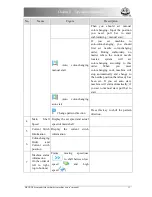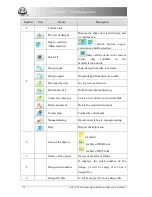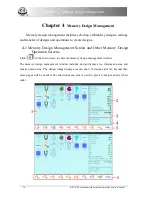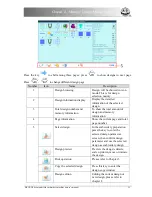
Chapter 2 Operation Instruction
2-8
Normal Embroidery, Returning and mending
In embroidery confirmation status (the icon
appears), push the switch of machine head
(that needs perform normal embroidery) to the normal embroidery mode, and push the switch
of machine head that needn’t embroider to the mending mode, and then pull the operation bar to
right and release it to let the machine start normal embroidery. (When you pull the bar right and
don't release it, the machine will embroider in lower speed.) During the embroidery, pull the bar
to left, the machine will stop.
After the machine stops, pulling the operation bar to left again will have the frame return to its
last position along original path. Pull the bar one time, the frame returns one needle step. Pull
the bar continuously and the frame will return one needle step after another continuously. After
the frame returns 10 needle steps continuously, the frame can return continuously even when
you release the bar. (This may be different for different machine types). When the frame return
continuously, release the bar and pull it left again, the frame will stop returning.
The aim for returning is usually to perform mending embroidery. After the returning stops, push
the switch on machine head that needs perform mending embroidery to go to the mending mode,
and then pull the operation bar to right and the machine head will start mending embroidery
while other heads remain inactive. When the frame goes to the point where the frame begins to
return, other heads whose mending switches are in normal embroidering mode will start to
embroider.
2-9
Relations between Normal Embroidery, Idling and Position Idling
Functions as idling, returning, etc. are intended for the convenience of patching. Low-speed
idling, high-speed idling or positioning idling can be used as needed in embroidery. In the status
of idling, the returning also has low-speed idling returning, high-speed idling returning or
positioning idling returning.
In the main screen, pressing
“
”
is to shift among “
” (normal embroidery), “
”
(low speed idling) and “
” (high speed idling).
After user sets low-speed idling
, the main shaft remains inactive when user pulls bar for
normal embroidery, but the frame runs forward along the stitch trace. When user pulls bar for
returning, the main shaft keeps inactive, but the frame returns along the stitch trace.
After user sets high-speed idling
, the main shaft and frame remain inactive, the stitch
number increases based on a unit of 100 stitches. After user pulls the bar for halting, the
frame moves directly to the actual position of the current stitch number. When user pulls bar for
returning, the main shaft and frame keep inactive, but the stitch number decreases. After user
pulls the bar for halting, the frame returns directly to the actual position of the current stitch
number.
The positioning idling can move the frame directly forwards (or backwards) to a designated
position, or to the latest color-change position, or even to the latest stop-code position. In the
BECS-D56 computerized embroidery machine owner’s manual
21
Содержание BECS-D56
Страница 2: ......
















































